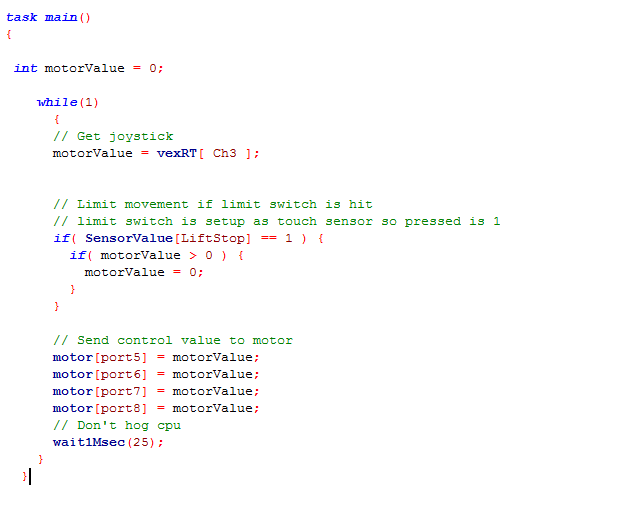

The Control subsystem A picture by vexrobotics, released under Creative Commons license.

The optical shaft encoder lets you measure the number of revolutions and the direction of a rotating shaft and the potentiometer lets you measure the angular position of something. There are also other sensors – an accelometer, a light sensor, an infrared line follower sensor, an ultrasonic range finder, an optical shaft enconder and a potentiometer. You can mount it on your robot and hit him if he does something wrong. One responds to a light touch, while the other is more like a hit sensor. So, what sensors there are in the Vex robotics system? There are two touch switches – a limit switch and a bumper switch. This way the robot can respond to various stimuli as programmed. The Sensor subsystemĪs you can understand, the Vex robotics design system’s Sensor subsystem includes sensors – devices that “read” the surrounding environment. If you opt for AA rechargeables – don’t use alkaline cells for a robot, NiCd are better suited for that. 7.2 volt battery pack is needed for a robot and 9.6 volt power pack for the transmitter. Regarding the rechargeable batteries you’d have to buy 14 AA cells – 6 batteries for your robot (the microcontroller) and 8 for the transmitter if you’d like to control the bot yourself.Īnother option is the above mentioned rechargeable battery packs. You can use regular AA rechargeables with a battery holder, or you can use vex robotics battery packs.

Servomotors, on the other hand, rotate to a certain degree – lift a crane for example. Regular motors rotate all the time, thus they can provide propulsion, for example. If you don’t know the difference between them, I’ll briefly describe it. There are also two types of motors under the motion subsystem – servomotors and continuous rotation motors (continuous rotation servos). Various sized wheels, including omni-wheels (wheels that can travel in any direction) and treads are available as well. This way they can spin freely in the bearing while still transfer the force to gears. The shafts are squared with rounded corners. Beware though – if too much force is applied the shaft can slip out and damage the gear. Vex gears have square holes in the center so you can use them with square shafts. There are different gears that you can use to increase torque and decrease speed or vice versa. This subsystem includes everything that enables movement – gears, bearings, squared shafts, rollers, wheels, treads and motors. The structural subsystem includes threaded standoffs that can be used to make multiple-platform robots as well. This is why I mentioned above that Vex structural parts can be used for other robotics projects as well. These sheet-metal parts are designed to be modified, so they can be easily bent and cutCylindri to adjust to your needs. So these are steel or aluminum sheet-metal parts with pre-fabricated square holes and compatible hardware – screws, nuts, etc. The Structural subsystemĪs you can guess, the structural subsystem includes structural parts – all those parts that make the robot’s body. As that is the way manufacturer explains everything in the “vex inventor guide”, I’ll stick to it as well. In order to better explain the main robot building concepts and to keep everything nice and tidy, the Vex system is divided into subsystems. Let me tell you more about the Vex robotics design system itself, the available Vex kits, programming options and some other things that’ll come up my mind. While this may seem insignificant to experienced robot builders, the experience can be priceless for everyone else. This is also a great way to learn about robot building and its main concepts. However, the true power of this system can be seen if all Vex robotics components are used together. Although there are some full-robot kits that introduce you to Vex, there are also various Vex components that can be easily used for your own robotics projects, such as structural parts, wheels, caterpillars, et cetera. So, the Vex robotics system deserves to be called like that because it actually is it. A picture by vexrobotics, released under Creative Commons license. Manufacturer’s description – “design system” is much more appropriate. Although I called it “a kit” that poorly describes it. Vex robotics design system is another robot construction kit that lets you build many different robots using parts, sensors and other stuff designed to fit together as you imagine.


 0 kommentar(er)
0 kommentar(er)
